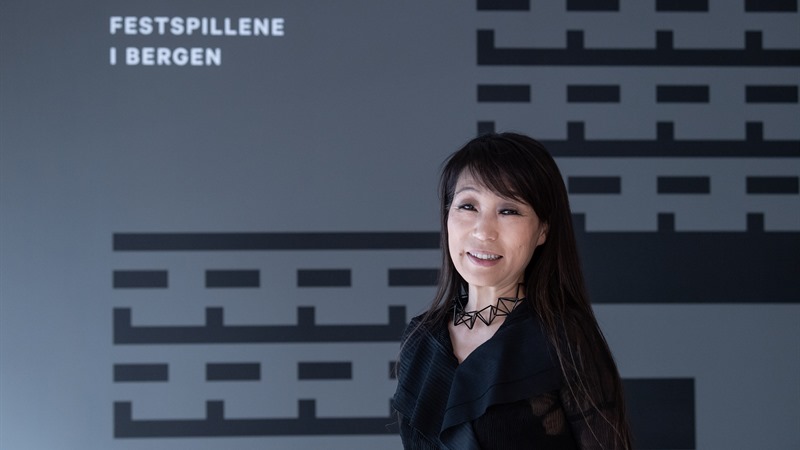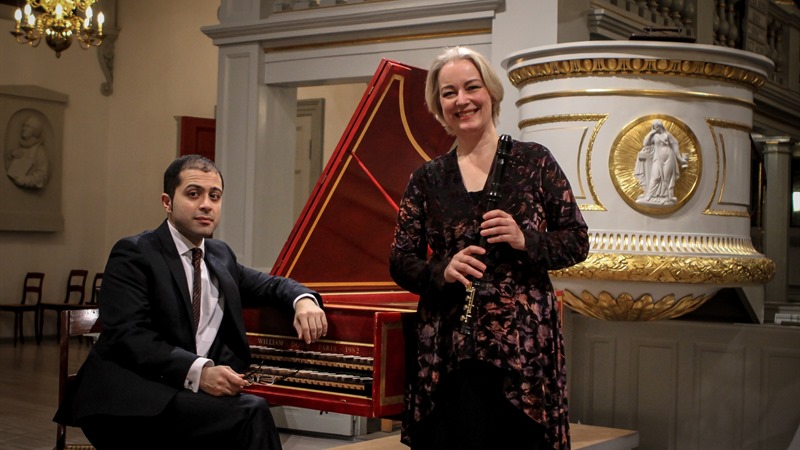Ole Bull sounds like some legendary gun-slinging hero of the Wild West. A legend he definitely was, and he spent long enough in the US to found a migrant community in Pennsylvania. But the Norwegian virtuoso (1810-1880) made his name not with a rifle but a fiddle. Back in Bergen, his birthplace, Norway’s first global superstar bought an entire island, Lysøen. He commissioned a fantasy mansion there from the architect Conrad von der Lippe. A Moorish dream in blue-grey pine, the Lysøen house makes an absurdly picturesque venue – one of several scattered in and around the coastal city – for the Bergen International Festival.
Now directed by Anders Beyer, and almost as long-established as Edinburgh, the festival spans art-forms, and balances reinterpreted tradition with experimental modernity, in much the same way as its Scottish counterpart. On a stereotypical Bergen day of soft late-spring rain falling on the garish rhodedendrons, I heard violinist Annar Follesø and pianist Wolfgang Plagge fill the Alhambra-like salon at Lysøen with its builder’s own violin showpieces. They intercut these richly romantic slices of Bull with some Paganini – the Norwegian’s immediate forerunner as world-renowned fiddler-god – and half-a-dozen Scott Joplin rags, played in Itzhak Perlman’s loving arrangements. Follesø and Plagge skipped stylishly, and wittily, between the pop, folk and art-music elements of their calorific Victorian high-tea – a synthesis prominent elsewhere in the Bergen line-up, but without any “fusion” absurdities.
 “I don’t compose crossover,” insisted festival composer-in-residence Unsuk Chin when I talked to her. Manifestly not: the uncompromisingly avant-garde soundscape of the Berlin-based Korean has, or at least originally had, strong affiliations with the work of her teacher, György Ligeti. Yet Chin (pictured above by Thor Brødreskift) has often drawn her themes and motifs from theatre, circus and pantomime, as well as from literary absurdism (her only full-length opera is a version of Alice in Wonderland). She likes Bergen because of the festival's “wide perspectives” and diversity of forms, lapped up by receptive audiences that “don’t have any dogmas. They enjoy different kinds of things.” That suits a composer who says that “I’m always trying to find a way to escape from Western classical music, even though I’m doing it. I’m trying to find my own language.” That language includes the score for the Beckett-influenced dance-drama of cosmigimmicks. It was performed, with sizzling commitment, amid the severe Modernist spaces of the Grieghallen (for once, an un-pretty Bergen venue), by the BIT20 Ensemble, together with Carte Blanche – Norway’s contemporary dance troupe. Semi-improvised movement accompanies music that – as often with Chin’s work – reimagines instrumental sound. She coaxes unearthly, mesmeric textures and timbres out of ear-bending combinations: in this case, viola, harp and mandolin alongside an array of precisely calibrated percussion. Then came the two parts of Ligeti’s Aventures, with its nonsense-language admirably voiced by soloists Donatienne Michel-Dansac, Omar Ebrahim and Kai Wessel. Aventures proved how much sheer parodic fun, as well as unsettling beauty, can be extracted from the Hungarian master’s fearless assaults on musical convention – novelty percussion (mallets, smashed crockery, ripped newspapers) and all.
“I don’t compose crossover,” insisted festival composer-in-residence Unsuk Chin when I talked to her. Manifestly not: the uncompromisingly avant-garde soundscape of the Berlin-based Korean has, or at least originally had, strong affiliations with the work of her teacher, György Ligeti. Yet Chin (pictured above by Thor Brødreskift) has often drawn her themes and motifs from theatre, circus and pantomime, as well as from literary absurdism (her only full-length opera is a version of Alice in Wonderland). She likes Bergen because of the festival's “wide perspectives” and diversity of forms, lapped up by receptive audiences that “don’t have any dogmas. They enjoy different kinds of things.” That suits a composer who says that “I’m always trying to find a way to escape from Western classical music, even though I’m doing it. I’m trying to find my own language.” That language includes the score for the Beckett-influenced dance-drama of cosmigimmicks. It was performed, with sizzling commitment, amid the severe Modernist spaces of the Grieghallen (for once, an un-pretty Bergen venue), by the BIT20 Ensemble, together with Carte Blanche – Norway’s contemporary dance troupe. Semi-improvised movement accompanies music that – as often with Chin’s work – reimagines instrumental sound. She coaxes unearthly, mesmeric textures and timbres out of ear-bending combinations: in this case, viola, harp and mandolin alongside an array of precisely calibrated percussion. Then came the two parts of Ligeti’s Aventures, with its nonsense-language admirably voiced by soloists Donatienne Michel-Dansac, Omar Ebrahim and Kai Wessel. Aventures proved how much sheer parodic fun, as well as unsettling beauty, can be extracted from the Hungarian master’s fearless assaults on musical convention – novelty percussion (mallets, smashed crockery, ripped newspapers) and all.
The evening ended with Chin’s own Gougalōn, inspired by Korean street-theatre. Chin, though, keeps her distance from musical “roots”. Gougalōn offers not folkloric pastiche, but a beguiling journey through the musical languages of marching bands and carnival buskers, with scrambled impressions of New Orleans, fin-de-siècle Vienna, maybe Charles Ives’s New England – albeit all glimpsed in an East Asian mirror. Chin explained to me how her early immersion in electronic music had sensitised her to “the inner world of sound”, and helped her “widen my sonic imagination”. In a work like Gougalōn, that search for “new ways of playing, and new combinations” carries her a long way from Ligeti’s sound-world. Still, her mentor would surely applaud. “I always had some musical and personal distance from him,” she recalls. “But his attitude was very important for me. He was never satisfied with himself.” The music alone mattered for him. As it does for her.
 With ears attuned by Chin’s micro-surgical extraction of new-minted sounds from strings and woods, the recital given by Michala Petri and Mahan Esfahani (pictured above by Sven Withfelt) in the medieval King Hakøn’s Hall became even more of an aural treat. You might imagine that this huge, vaulted 13th-century barn, part of Bergen’s harbourside fortress, would chew up and spit out the fragile voices of a recorder and harpsichord duo in short order. The hall, however, has surprisingly warm and sensitive acoustics. We heard all the silvery delicacy you would expect from a Bach-focused programme with these instruments, but robust muscularity as well. Petri, whom I remember as the Danish prodigy who with her own small hands restored the fortunes of the humble recorder, plays its glorious Baroque repertoire with supreme authority, and enormous charm. She switched instruments as the pieces changed, from tiny soprano to full-throated tenor. Two solo works written for her in the 1970s reminded us that she had secured for music’s Cinderella pipe a glittering presence at the grandest of balls. Esfahani, meanwhile, proved a congenial and resourceful accompanist: less of the volatile Marlon Brando of the harpsichord than he can sound when playing alone. His solo flourish came in a performance of Bach’s Italian Concerto: big-boned, full-flavoured, rhythmically free (even slightly cheeky). Yes, he banishes daintiness from his keyboards – but not, thank goodness, subtlety or refinement.
With ears attuned by Chin’s micro-surgical extraction of new-minted sounds from strings and woods, the recital given by Michala Petri and Mahan Esfahani (pictured above by Sven Withfelt) in the medieval King Hakøn’s Hall became even more of an aural treat. You might imagine that this huge, vaulted 13th-century barn, part of Bergen’s harbourside fortress, would chew up and spit out the fragile voices of a recorder and harpsichord duo in short order. The hall, however, has surprisingly warm and sensitive acoustics. We heard all the silvery delicacy you would expect from a Bach-focused programme with these instruments, but robust muscularity as well. Petri, whom I remember as the Danish prodigy who with her own small hands restored the fortunes of the humble recorder, plays its glorious Baroque repertoire with supreme authority, and enormous charm. She switched instruments as the pieces changed, from tiny soprano to full-throated tenor. Two solo works written for her in the 1970s reminded us that she had secured for music’s Cinderella pipe a glittering presence at the grandest of balls. Esfahani, meanwhile, proved a congenial and resourceful accompanist: less of the volatile Marlon Brando of the harpsichord than he can sound when playing alone. His solo flourish came in a performance of Bach’s Italian Concerto: big-boned, full-flavoured, rhythmically free (even slightly cheeky). Yes, he banishes daintiness from his keyboards – but not, thank goodness, subtlety or refinement.
In the super-sized main auditorium of the Grieghallen, Robert Wilson’s production of The Sandman (pictured below by Lucie Jansch) lent the festival a dramatic centrepiece crammed with splashily audacious features. The dream-like magic of theatre suffuses this dramatisation of ETA Hoffmann’s Gothic tale by the American avant-garde guru. Wilson, the veteran spellbinder who has worked with everyone from Philip Glass and Martha Graham to Tom Waits and Lady Gaga, transforms Hoffmann’s much-adapted story of childhood night-terrors and sinister automata into a “grusical”: a horror-musical. He sews its dark fabric with macabre sequins of stagecraft, from the creepy mechanical toys who greet us, and the nightmare cabaret of the child Nathanael’s dreams about an eye-plucking Sandman, to the climactic ball of mirrors and illusions. Here, the adult hero must accept that his beloved Olympia – manufactured by ghastly Dr Coppelius – is but a clever clockwork toy. In an age haunted by uneasy dreams of robots, replicants and simulacra, and as AI burrows ever deeper into the human imagination, there’s no denying The Sandman’s lasting power. Wilson wields all his alchemical skill in updating it, pulling every trick from his ti-tech magician’s box. Yet, for me, the whey-faced, mechanical, Expressionist-cabaret style of much of this performance gave rise to more drollery than dread. A century has passed, after all, since Wiene’s The Cabinet of Dr Caligari – the ultimate source of so much Gothic-Modernist grotesquerie. It all looked a bit too stylish to be properly scary.
 Perhaps, these days, we feel too much at home with the art of the uncanny – the unheimlich or, in Norwegian, uhyggelig. However, the original score by Mercury Prize-shortlisted singer-songwriter Anna Calvi did add something strikingly fresh to the menacing mix. Calvi’s resonant techno-ballads seemed to belong in a less mannered and stylised domain than Wilson’s direction. They brought to mind not only David Bowie and PJ Harvey but the sepulchral sadness of that high wizard of the spooky anthem, Nick Cave himself.
Perhaps, these days, we feel too much at home with the art of the uncanny – the unheimlich or, in Norwegian, uhyggelig. However, the original score by Mercury Prize-shortlisted singer-songwriter Anna Calvi did add something strikingly fresh to the menacing mix. Calvi’s resonant techno-ballads seemed to belong in a less mannered and stylised domain than Wilson’s direction. They brought to mind not only David Bowie and PJ Harvey but the sepulchral sadness of that high wizard of the spooky anthem, Nick Cave himself.



Add comment